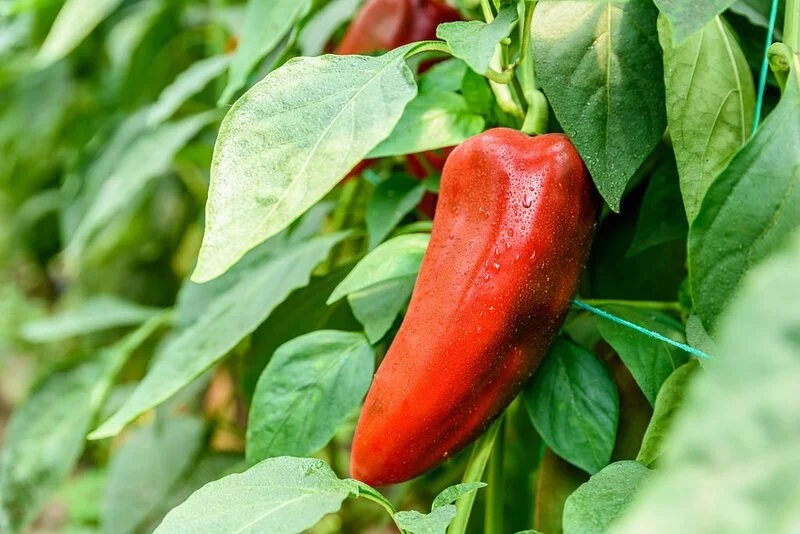There’s nothing quite like the satisfaction of biting into a juicy, vibrant red pepper that you’ve grown yourself. From its radiant color to its sweet, tangy flavor, a home-grown red pepper is a joy to behold and a delight to taste. But one question that many budding gardeners ask is, “How many of these delicious red beauties can one plant produce?” Today, we’re embarking on a journey to find the answer. Fasten your seat belts, folks, because we’re diving deep into the world of red pepper production.
- Bright Red, blocky Pepper with thick walls – Great for stuffing
- Mild, sweet flavor with a hearty Crunch
- Ripen from green to Red
- Great for containers and may need to be staked
- Chopped peppers freeze well
Red Pepper Plants
Red pepper plants, with their lush green leaves and vibrant fruits, are truly a sight to behold. But before we delve into the number of peppers they can produce, let’s get to know these plants a little better.
Red pepper plants are part of the Capsicum family, which also includes their spicy cousins, the chilli peppers. They love basking in the sunshine, drinking up the warm rays to help them grow strong and healthy. These plants start their life cycle bearing green fruits, which ripen over time to become the brilliant red peppers we all know and love.
But here’s where it gets interesting: the number of peppers each plant can produce isn’t just a matter of the plant’s natural capabilities. It’s also heavily influenced by a range of factors, from the care they receive to the conditions in which they grow.
Ready to learn more? Let’s dig deeper into the factors that influence the yield of a red pepper plant.
Factors Influencing Red Pepper Yield
Just like us, red pepper plants need the right conditions to thrive. It’s not just a matter of planting them and hoping for the best. There are several factors that can influence how many peppers your plant will yield.
First up is sunlight. Red peppers love the sun. They need at least six to eight hours of it every day. So if you want a bumper crop of peppers, be sure to pick a sunny spot in your garden for your plants.
Secondly, water. Red pepper plants need a good amount of water, but they don’t like to have their roots soaking all the time. Too much water can cause their roots to rot, and too little can make them wilt. It’s all about balance.
Next, the soil. Red peppers like well-draining soil, rich in organic matter. If the soil is too heavy or too sandy, it can affect the health of the plant and thus the number of peppers it can produce.
Finally, care. Regular feeding with a balanced fertilizer can help your red pepper plants produce more fruits. Similarly, proper pest management can keep your plants healthy and fruiting.
Average Yield of a Red Pepper Plant
Now, let’s get down to numbers. How many red peppers can one plant produce? On average, a healthy red pepper plant can produce around 6 to 8 peppers per plant per season. However, with optimal care and conditions, some plants can yield as many as 10 to 12 fruits.
It’s important to remember that these are average numbers and the actual yield can vary based on the factors we discussed above. But with the right care and a little bit of gardening magic, your red pepper plants can gift you with a wonderful harvest. Ready to learn how to maximize your red pepper yield? Let’s continue our journey!
Maximizing Your Red Pepper Yield
So, you’re dreaming of a bountiful harvest of glossy, scarlet peppers. How do you turn this dream into a reality? Here are a few tips:
- Proper Planting: Start right to end right. Plant your red peppers in a sunny spot and give each plant enough space to grow. This typically means leaving about 18 to 24 inches between each plant.
- Water Wisely: Remember, red pepper plants like a drink, but they don’t like to swim. Water them regularly, but make sure the soil drains well and doesn’t stay soggy.
- Feed Them Well: Using a balanced fertilizer can give your red pepper plants the nutrients they need to produce a lot of fruits.
- Pest Control: Keep an eye out for common pests like aphids and caterpillars. Using organic pesticides or beneficial insects can help keep these pests in check.
- Harvest Timely: Don’t be too eager to pick your peppers. Wait until they’re fully ripe and their color is vibrant red. But don’t wait too long either, as overripe peppers can reduce the plant’s overall yield.
- High Purity Phosphate: RAW Phosphorus boasts 61% pure water-soluble phosphate, ensuring a potent and effective phosphorus source for your plants.
- Versatile Application: Whether you’re nurturing plants indoors, outdoors, or through hydroponics, RAW Phosphorus seamlessly integrates into various growing environments.
- Rooting Stage Support: Specifically beneficial in the early rooting stage, RAW Phosphorus nurtures robust root development, laying the foundation for healthy plants.
- Energy for Fruit and Flowering: Beyond rooting, RAW Phosphorus provides essential energy during fruit and flower production, ensuring a bountiful harvest.
- Incorporate RAW Phosphorus into your regular feeding routine during the flowering stage for optimal results. Follow the recommended dosage on the label to infuse your plants with the right balance of phosphorus and nitrogen.
Conclusion
Growing your own red peppers can be a rewarding journey, from the first sprouts breaking through the soil to the satisfaction of biting into a pepper you’ve grown yourself. Although the number of peppers one plant can produce varies, with the right conditions and care, you can look forward to a generous harvest. Remember, gardening is part patience, part science, and part love. So keep nurturing your plants, and they’ll reward you with a cornucopia of crunchy, sweet red peppers.





